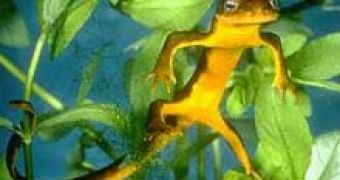One of the apparent mysteries of Darwinian evolution is how can random mutations generate beneficial effects. The number of possible harmful effects seems to greatly overwhelm the number of possible beneficial effects. Imagine you would start making random changes to a television. What is the probability that you will end up with a better television? Virtually zero. You would most likely end up with a television that doesn't work at all. If this is true for a television, how could it not be true for a living creature which is incredibly more complex than a television? How could one obtain e.g. a bird via a long process of random changes to a frog?!
The explanation is in fact fairly simple. One needs to understand in what fundamental way a living creature is different from a television and, implicitly, in what fundamental way the evolution of technology is different from the evolution of life. In fact, life is so complex that it simply cannot evolve in the same way as technology evolves and, as technology becomes more and more complex, its evolution increasingly begins to resemble the Darwinian evolution.
The key concept here is the concept of meta-system transitions. This allows us to understand evolution in abstract cybernetic terms in a way that isn't necessarily connected to any particular thing that evolves. It applies to the evolution of life, to the evolution of language, to the evolution o social practices, to the eventual evolution of very complex technology etc. It applies to any kind of evolution that isn't guided by an external designer. The main idea is that complex things have hierarchic structures. For example an animal is made out of molecules that are incorporated into cells, the cells are incorporated into tissues, the tissues are incorporated into organs, the organs are incorporated into one animal. This could go on even further in both directions: the molecules are made out of atoms, that are made out of electrons and atomic nuclei, the atomic nuclei are made out of protons and neutrons, and these are made out of quarks; while the animals are incorporated into groups of animals and these are part of the an ecological system and the ecological systems are part of the global ecology.
The point here is that there exists a certain level of organization that is privileged. For example, in case of human beings the privileged level in the individual human being, and not, e.g. our cells or the society. In what sense is a level or organization privileged? In the sense that all the other levels of organization serve its purposes. E.g. the society exists because it is in the interests of the individual human beings to be part of a society, and everything that happens inside one human being has the purpose of keeping the individual alive.
In case of other animals such as honeybees or ants, the privileged level of organization is the level of the bee swarm or that of the anthill. In case of these animals, the goals of individual ants or bees are overrun by the goals of the entire anthill or bee swarm. The individual bee is not independent; it is entirely subjugated to the bee swarm.
Evolution always happens at the stage of the privileged level of organization - i.e. this is the level where natural selection happens. In case of ants natural selection selects anthills, not individual ants, in case of e.g. dogs, natural selection selects individual dogs and not packs of dogs. A meta-system transition is when the privileged level of organization changes. For example, when a multi-cellular animal appears, the individual cell is no longer the privileged level of organization; it becomes subjugated to the higher organization. Similarly, a multi-cellular tissue is used for a certain function inside an organ. A complex thing is something that incorporates many such hierarchical levels.
Now, to return to the initial question: How does Darwinian evolution manage to avoid the occurrence of countless of potential harmful changes? How does it do it in spite of the fact that mutations are random, that evolution happens by trial-and-error? The answer is that the random changes always occur only at the highest level of organization. I.e. the main basic features are not changed, the only thing that changes is how the basic features are combined together. You can imagine this with the help of a metaphor: imagine a state that keeps on changing only the organization of the government and its ministries but that always keeps intact all the "ground-level" features. This way, the total number of possible changes is much lower and thus, the trial-and-error game is possible. On the other hand, this means that any evolved animal includes in itself the basic features of all the primitive animals from its lineage. This is found to be indeed true. For example, the frog has a very primitive visual system; a frog is incapable of observing something standing still, all it observes is movement (this helps it catch insects or escape predators). The frog is one of our ancestors, so? Well, it is found that our own visual system is simply based on the frog's visual system: we cannot see still things either, but unconsciously our eye balls constantly move. Our visual system didn't learn how to see still things, it just improved the frog's visual system. Similarly, a part of our brain is a remnant of reptiles' brain. Our brains didn't replace the reptile brain with a better one, but our brains are further developments of the reptile brain incorporating all the successful features of those brains.

 14 DAY TRIAL //
14 DAY TRIAL //